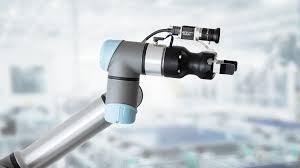How ABB, Basler, and Teledyne Are Shaping the Future of Vision-Guided Robotics Industry

Strong 8k brings an ultra-HD IPTV experience to your living room and your pocket.
Introduction:
The field of Vision-Guided Robotics (VGR) is experiencing rapid growth, driven by advancements in artificial intelligence (AI), machine learning, and computer vision. Vision-guided robots use cameras, sensors, and advanced algorithms to "see" and navigate their environments, performing tasks such as object identification, quality control, assembly, and autonomous navigation. Companies like ABB, Basler, and Teledyne are playing a pivotal role in shaping the future of the vision-guided robotics industry, driving innovation and enhancing the capabilities of robots across a wide range of industries, from manufacturing to healthcare.
In this article, we will explore how ABB, Basler, and Teledyne are revolutionizing the vision-guided robotics industry by providing cutting-edge solutions and technologies that enable robots to perform complex tasks with greater precision, speed, and efficiency. We will also delve into the integration of vision systems with autonomous mobile robots (AMRs) and the role these companies are playing in advancing this technology.
The Growing Importance of Vision-Guided Robotics
Vision-guided robotics combines machine vision and robotics to enable machines to "see" and make decisions based on visual inputs. This integration has opened up new possibilities for automation, particularly in industries such as manufacturing, logistics, healthcare, and agriculture. By using vision systems, robots can perform tasks that were previously difficult or impossible for automated systems, including:
• Object recognition and sorting
• Quality control and inspection
• Pick-and-place tasks
• Autonomous navigation in dynamic environments
• Human-robot collaboration
The rise of automation, coupled with advancements in vision technologies, has made vision-guided robotics a crucial element in modern industrial applications. The demand for more sophisticated vision systems is fueling the growth of the vision-guided robotics market, with key players like ABB, Basler, and Teledyne leading the charge.
ABB: Leading the Way in Robotic Vision Integration
ABB, a global leader in industrial automation and robotics, has been at the forefront of integrating vision systems with robotics. The company's vision-guided robotics solutions combine advanced robotic arms with high-performance vision systems to enable robots to execute precise tasks in a variety of industries.
ABB’s Robotics and Vision Solutions
ABB’s robotics portfolio includes a wide range of robots, from collaborative robots (cobots) to heavy-duty industrial robots, equipped with advanced vision systems. These systems provide robots with the ability to recognize objects, inspect components, and perform tasks with high accuracy.
ABB’s “PickMaster” software integrates vision systems with robots to enhance pick-and-place operations in manufacturing and logistics environments. The vision system provides real-time feedback to the robot, enabling it to accurately pick items from complex or disorganized surfaces. This capability is particularly valuable in applications such as e-commerce fulfillment, food packaging, and automotive assembly, where high-speed, precise, and flexible automation is critical.
In addition to its robotic arms, ABB’s software solutions such as “RobotStudio” allow users to simulate and program vision-guided robotic tasks without the need for physical prototypes. This software accelerates the development of automation systems, making it easier for companies to deploy vision-guided robots quickly and efficiently.
Autonomous Mobile Robots (AMRs) Integration
ABB is also making significant strides in integrating vision systems with autonomous mobile robots (AMRs), which are becoming increasingly popular for tasks such as material handling, inventory management, and warehouse automation. AMRs are equipped with sensors and vision systems that allow them to navigate dynamic environments, avoid obstacles, and interact with human workers.
ABB’s AMRs, such as the “YuMi” cobot and “OmniMove” mobile robot, integrate computer vision technologies to identify objects, navigate narrow aisles, and interact with both machines and humans in collaborative settings. These robots can dynamically adjust their movements based on real-time visual feedback, making them highly adaptable to various industrial settings.
Basler: A Visionary Leader in Machine Vision Cameras
Basler, a leading manufacturer of machine vision cameras, is a key player in the vision-guided robotics space. The company specializes in providing high-performance cameras that enable robots to perceive their environment with exceptional clarity and precision. Basler’s cameras are widely used in applications such as quality inspection, sorting, and tracking, where visual feedback is crucial for task execution.
Basler’s Contribution to Vision-Guided Robotics
Basler’s extensive portfolio of industrial cameras, which includes area scan, line scan, and 3D cameras, plays a vital role in providing vision solutions for robotics. These cameras are capable of capturing high-resolution images, enabling robots to recognize and inspect objects with high accuracy.
Basler’s cameras are designed to be easily integrated into robotic systems, providing flexibility for system developers and integrators. The company offers a range of cameras equipped with features such as high-speed image processing, low-light sensitivity, and high frame rates, which make them suitable for demanding robotics applications.
Basler’s Cameras in Autonomous Mobile Robots (AMRs)
In the AMR market, Basler’s vision systems are widely used to enable robots to navigate complex environments and make decisions based on visual data. For instance, Basler’s 3D cameras provide depth perception, allowing robots to navigate around obstacles and pick up objects with precision. These vision systems enhance the capability of AMRs to perform tasks such as inventory management, parcel delivery, and goods transportation in warehouses and logistics centers.
Basler’s cameras are also used in systems for real-time monitoring and inspection, where visual feedback is critical for detecting defects, ensuring quality, and maintaining safety. The ability of Basler cameras to deliver high-resolution, accurate images at high speeds is a key factor in their success in these applications.
Teledyne: Advancing Vision Technology for Robotic Applications
Teledyne, a global leader in imaging and sensors, has been at the forefront of developing cutting-edge vision technologies for robotic applications. The company provides a wide range of imaging solutions that enable robots to perform complex tasks, from assembly and inspection to navigation and interaction.
Teledyne’s Role in Vision-Guided Robotics
Teledyne offers a variety of imaging systems, including high-definition cameras, sensors, and optical components, designed to meet the demands of robotics applications. These systems provide robots with the ability to perceive their environment and make intelligent decisions based on visual input.
Teledyne’s imaging technology is used in various robotic applications, such as automated quality control, precision assembly, and warehouse automation. By integrating Teledyne’s advanced imaging systems into robotic arms and AMRs, robots are able to perform tasks with greater accuracy and speed.
Teledyne’s 3D Vision Solutions for AMRs
Teledyne is also a leader in 3D vision technology, which is a critical component in the navigation and manipulation capabilities of autonomous mobile robots. Teledyne’s 3D vision solutions allow robots to see and understand their environment in three dimensions, providing a more comprehensive view of obstacles, objects, and people.
In AMR applications, Teledyne’s 3D cameras enable robots to map their environment, navigate complex layouts, and interact with dynamic objects. This technology allows AMRs to autonomously transport goods in warehouses, distribution centers, and manufacturing plants, while avoiding obstacles and interacting with human workers safely.
Exploring the Integration of Vision Systems with Autonomous Mobile Robots (AMRs): The Role of ABB, Basler, and Teledyne
The integration of vision systems with autonomous mobile robots (AMRs) is one of the most exciting developments in the field of robotics. Vision systems enable AMRs to perceive their surroundings, make informed decisions, and carry out tasks autonomously in dynamic environments. ABB, Basler, and Teledyne are leading the way in this area, providing cutting-edge vision technologies that enhance the capabilities of AMRs.
ABB’s Vision Integration for AMRs
ABB’s AMRs are equipped with advanced vision systems that allow them to navigate warehouses, factories, and distribution centers with precision. Using computer vision and AI algorithms, ABB’s robots can identify objects, avoid obstacles, and optimize their routes for faster and more efficient task execution. This makes ABB’s AMRs ideal for material handling, order picking, and other logistics tasks.
Basler’s Cameras in AMRs
Basler’s cameras play a vital role in enabling AMRs to perform complex tasks with visual feedback. By integrating high-resolution 3D cameras into their robots, Basler enhances the ability of AMRs to perceive objects and navigate their environments with greater accuracy. This technology allows robots to interact with their surroundings in real time, improving operational efficiency in industries such as logistics and manufacturing.
Teledyne’s Advanced Vision for AMRs
Teledyne’s advanced 3D vision systems provide AMRs with the ability to map environments and avoid obstacles while performing tasks such as delivery, inventory management, and inspection. Teledyne’s cameras are equipped with high-definition imaging capabilities and are optimized for real-time data processing, enabling AMRs to make quick and accurate decisions based on visual input.
Conclusion
ABB, Basler, and Teledyne are key players in the vision-guided robotics industry, driving innovation and transforming how robots interact with their environments. Through advanced vision systems, these companies are empowering robots to perform tasks with greater precision, speed, and efficiency. The integration of vision systems with autonomous mobile robots (AMRs) is one of the most exciting developments in this space, and ABB, Basler, and Teledyne are at the forefront of this revolution, shaping the future of robotics and automation across industries. As the demand for smarter, more capable robots grows, these companies will continue to play a crucial role in advancing vision-guided robotics technologies and shaping the future of automation.
Read the complete blog https://www.nextmsc.com/blogs/abb-basler-teledyne-shaping-vision-guided-robotics-market
Note: IndiBlogHub features both user-submitted and editorial content. We do not verify third-party contributions. Read our Disclaimer and Privacy Policyfor details.







